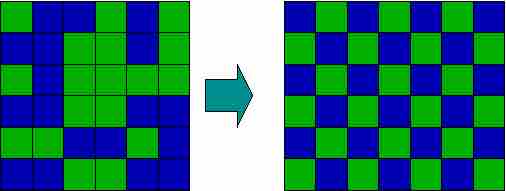Entropy
As anyone who has shuffled a deck of cards knows, disordered arrangements of objects are statistically more favored, simply because there are more ways in which they can be realized. The more the number of objects increases, the more statistics governs their most likely arrangements. Chemistry deals with a huge number of objects (molecules), and their tendency to become as spread out and disordered as possible can become overwhelming. However, when they become spread out and disordered, the thermal energy they carry with them is also dispersed; the availability of this energy as measured by the temperature is also of importance. Chemists use the term "entropy" to denote this aspect of molecular randomness. Entropy is indeed a fascinating, but somewhat confusing, topic. In fact, it is so important that the topic of entropy deals with two of the three laws of thermodynamics.

Order and disorder
This image shows a series of blue and green squares going from a state of disorder (randomness) to a state of order (a clear repeating pattern). In this example, that is to say, entropy decreases and opposes the transition.
Entropy in Solution Formation
For now, entropy can be thought of as molecular "disorder" or in terms of the energy of molecules and how spread out they are. This term increases with increasing temperature. As a molecule changes state, the general states of matter can be ordered as follows in terms of entropy: gases > liquids > solids.
In a similar manner entropy plays an important role in solution formation. Entropy commonly increases especially for ions as they transition from molecule to ions. This is because we are essentially increasing the number of particles from one compound to two or more depending upon the composition. Consider, the dissolution of sodium sulfate,
Na2SO4(s) --> 2 Na+ (aq) + SO42-(aq)
The entropy is increasing for two reasons here:
- A solid is formed into aqueous media.
- One molecule is transformed into three ions.
All these factors increase the entropy of the solute. Also keep in mind that there is a loss of entropy associated with the water moleclues organizing their 'solvent cages' around the ions themselves. This factor can sometimes lead to only a small increase in entropy although a large increase is expected. Thus, in the very common case in which a small quantity of solid or liquid dissolves in a much larger volume of solvent, the solute becomes more spread out in space, and the number of equivalent ways in which the solute can be distributed within this volume is greatly increased. This is the same as saying that the entropy of the solute increases.
Think of entropy in solution formation by picturing the addition of food coloring to pure water. Upon first addition of the food coloring, the dye molecules are concentrated near their contact point. As time proceeds, these molecules of dye are dispersed more uniformly throughout the solution even without mixing. Since the Hsolution for this process is approximately zero (an ideal solution), the only thermodynamic factor driving the mixing is the entropy term.
If the energetics of dissolution are favorable, this increase in entropy means that the conditions for solubility will always be met. Even if the energetics are slightly endothermic, the entropy effect can still allow the solution to form, although they may perhaps limit the maximum concentration that can be achieved.